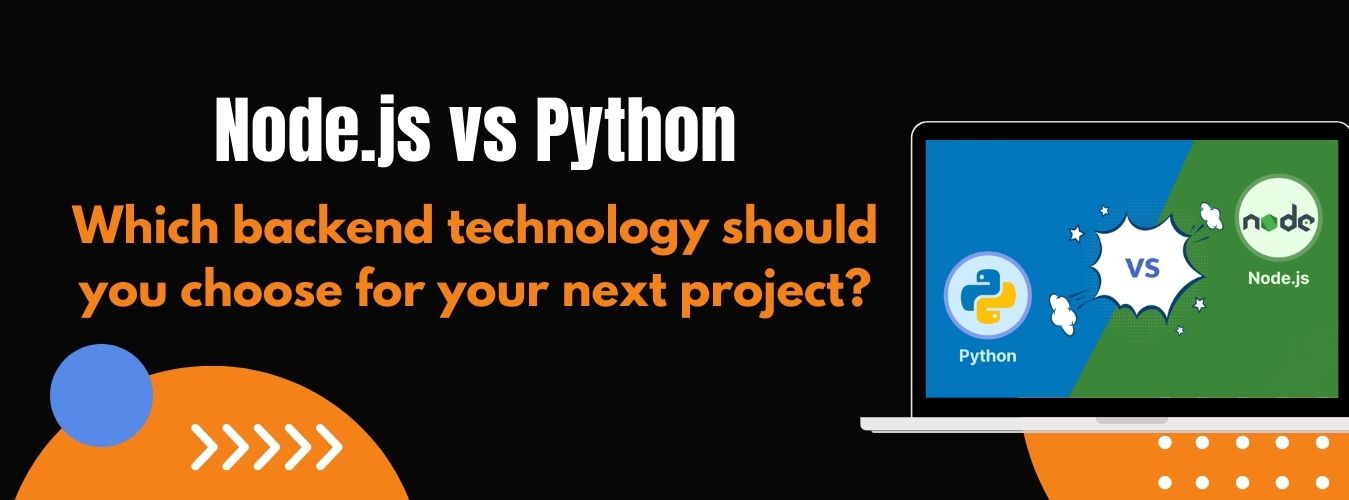In backend development, the topic of Node.js vs Python often perplexes developers seeking the best-suited technology for their projects.
Let’s delve into the intricacies of both technologies to guide you through this decision-making process.
Node.Js
98.8% of all websites employ JavaScript as a client-side programming language.
Node.js, built on Chrome’s V8 JavaScript engine, is lauded for its event-driven and non-blocking I/O model. It is efficient for handling concurrent connections. Its prowess in building scalable, real-time applications has made it a favorite among developers.
How Does Node.Js Work?
The key motivation for deploying Node.Js in production is to handle 100% Business Availability, even with a Massive Load.
Key Advantages of Node.js:
Efficiency & Performance:
Node JS is downloaded 78% for Linux, 17% for Windows, and 5% for macOS.
Leveraging the V8 engine, Node.js delivers outstanding performance. Its event-driven, non-blocking architecture ensures high scalability. It can handle numerous concurrent connections swiftly and efficiently.
JavaScript Everywhere:
Unifying frontend and backend development under JavaScript simplifies the tech stack. Developers can seamlessly switch between client and server-side scripting. Moreover, it can also facilitate code sharing and accelerate backend development.
The approach is easily accessible to 85% of JavaScript learners. The educational resources are excellent, according to 71% of JavaScript learners.
Rich Ecosystem of Libraries (npm):
Databases are used by 95% of Node JS developers in their applications. A library or frontend framework is used by around 86% of developers.
Node.js boasts npm (Node Package Manager), housing a vast repository of reusable modules. This treasure trove of libraries empowers developers with ready-made solutions for diverse functionalities.
Scalability & Real-time Applications:
43% of Node.js developers use it for corporate projects. Node.js excels in building real-time applications like chat apps and gaming platforms. Its event-driven model allows handling concurrent connections with ease. This makes it suitable for scalable, data-intensive, and real-time applications.
Enhanced Developer Productivity:
The platform’s single-language development streamlines the development process. Sharing code between the frontend and backend reduces context-switching to foster a more productive development environment.
Community Support & Active Development:
A vibrant and dedicated community continually contributes to Node.js to ensure regular updates, bug fixes, and new features. Active community support translates to reliable resources and quick issue resolution.
Microservices Architecture Compatibility:
Node.js seamlessly integrates with microservices architecture. Its lightweight nature and efficient handling of I/O operations make it an ideal choice for developing microservices-based applications.
Cost-Efficient & Suitable for MVPs:
Node.js’s rapid prototyping capabilities and lightweight architecture make it perfect for Minimum Viable Product (MVP) development. It helps in swiftly testing and iterating ideas before full-scale deployment.
Craft Your Ideal Node.Js App With Us!
Ready to elevate your business? Your Node.js app is just a click away.
Yes Let’s goPython:
Python is used as a server-side programming language by 1.4% of all websites on the internet!
Revered for its simplicity and readability, Python boasts a rich ecosystem of libraries and frameworks. Its straightforward syntax and versatility make it an attractive choice for various applications, from web backend development to data science.
Key Advantages:
Simplicity & Readability:
According to the PYPL index, Python is the most popular language so far, with Java as its nearest competitor.
Python’s clear and intuitive syntax fosters ease of learning and readability. Its resemblance to the English language simplifies coding to make it accessible for beginners and enjoyable for experienced developers.
Versatility & Multi-Purpose Nature:
Python has a strong presence in a variety of industries. Notably, it has a 9.01% popularity rate in the field of Science & Education.
Python’s versatility extends to various domains, including web backend development, data analysis, scientific computing, artificial intelligence, and automation. Its adaptability across these domains showcases its diverse utility.
Rich Ecosystem of Libraries and Frameworks:
Python is used extensively in digital entertainment, powering 15% of Spotify’s products and 28% of Netflix’s content delivery systems.
The language boasts an extensive collection of libraries and frameworks such as Django, Flask, NumPy, Pandas, and TensorFlow. These libraries streamline backend development, offering pre-built solutions and cutting down backend development time.
Community Support & Large User Base:
Python’s robust community support ensures continuous evolution and improvement. The extensive user base contributes to a vast pool of resources, tutorials, and documentation to aid developers in problem-solving and learning.
Ease of Integration:
Python seamlessly integrates with other languages and platforms, facilitating interaction with C/C++, Java, and .NET. This interoperability enhances its usage in various software development scenarios.
Excellent for Prototyping & Rapid Development:
Its simplicity and the availability of numerous libraries and frameworks make Python an ideal choice for rapid prototyping. It enables developers to transform ideas into functional prototypes swiftly.
Strong Focus on Code Readability and Maintainability:
Python’s emphasis on clean code and readability is enforced through indentation-based syntax. This leads to easily maintainable and understandable codebases.
Support for Automation and Scripting:
Python’s scripting capabilities and ease of automation empower developers to create robust scripts for automating mundane tasks to enhance productivity.
How Node.Js and Python Handle Asynchronous Operations?
Python Libraries vs Node.Js Speed
Node.js Vs Python: Which Backend Development to Prefer?
Performance and Scalability:
Node.js is ideal for real-time applications. On the other hand, Python handles complex algorithms and computation-heavy tasks.
| Performance and Scalability | Python | Node.js |
|---|---|---|
| Concurrency | Supports multithreading and multiprocessing for concurrent tasks, although the Global Interpreter Lock (GIL) can impact performance in CPU-bound tasks. | Event-driven architecture facilitates handling multiple concurrent connections efficiently. Best suited for I/O-bound tasks. |
| Performance | Generally performs better in CPU-bound tasks and complex algorithms due to mature and optimized libraries and implementations. | Excellent performance in handling asynchronous I/O operations, ideal for real-time applications and handling a large number of simultaneous connections. |
| Scalability | Scalable, but limitations in scaling due to GIL can affect performance in CPU-bound applications. | Well-suited for horizontally scaling applications with a large number of concurrent connections due to its non-blocking I/O model. Scales efficiently for I/O-bound tasks. |
| Ecosystem and Libraries | Offers a wide range of libraries and frameworks, making it versatile for various applications but might lack specific niche libraries. | Boasts an extensive package ecosystem (npm), catering to a broad spectrum of functionalities and a large repository of modules, but might lack maturity in certain domains. |
Ease of Learning and Syntax:
Python promotes clean, easily understandable code to enhance readability and maintainability. However, Node.Js offers a seamless transition between frontend and backend development due to its single language feature.
| Ease of Learning and Syntax | Python | Node.js |
|---|---|---|
| Learning Curve | Python boasts a gentle learning curve, offering a simple and readable syntax, ideal for beginners and emphasizing code readability and simplicity. | Node.js, leveraging JavaScript, offers a familiar syntax for frontend developers, allowing for easier transition and code reuse. |
| Readability | Known for its clean and readable code, Python employs indentation and a straightforward structure, enhancing code readability. | JavaScript syntax in Node.js can sometimes be less intuitive due to asynchronous programming concepts and nested callbacks. |
| Community Support | Python’s vast community provides extensive support, tutorials, and documentation, facilitating learning and problem-solving. | Node.js benefits from an active community, although its resources might not be as extensive and diversified as Python’s. |
| Learning Resources | A plethora of learning resources, including books, tutorials, online courses, and a rich library of documentation, aids in mastering Python. | Node.js offers numerous tutorials, guides, and documentation; however, it might have a slightly steeper learning curve for newcomers. |
Ecosystem and Libraries:
Node.js comes with npm (Node Package Manager) to offer a vast repository of packages that assist in various functionalities. Python caters to diverse needs, making it convenient for developers.
| Aspect | Python | Node.js |
|---|---|---|
| Package Management | PIP (Python Package Index) | NPM (Node Package Manager) |
| Frameworks | Django, Flask, Pyramid, FastAPI | Express.js, Koa.js, Sails.js, Nest.js |
| Web Development | Django (full-stack), Flask (lightweight) | Express.js (popular for web applications) |
| Data Science | NumPy, Pandas, SciPy, TensorFlow, Matplotlib | TensorFlow.js, Brain.js, D3.js |
| Machine Learning | Scikit-learn, TensorFlow, Keras, PyTorch | TensorFlow.js, Brain.js, Keras.js |
| Backend Development | Django, Flask, FastAPI, Tornado | Express.js, Hapi.js, Koa.js |
| Testing | PyTest, unittest, Nose, doctest | Mocha, Jasmine, Jest, Chai |
| Networking | Requests, Scrapy, urllib | Axios, Request |
| GUI Development | Tkinter, PyQT, Kivy | Electron, NW.js, Socket.io |
| Real-Time Applications | Django Channels, Socket.IO, Tornado | Socket.IO, SockJS, ws |
Concurrency and Async Programming:
Node.js is adept at handling asynchronous operations to make it suitable for handling numerous requests concurrently. Python offers multithreading and multiprocessing support to enable it to perform tasks together.
| Aspect | Python | Node.js |
|---|---|---|
| Concurrency Mechanisms | Offers multithreading and multiprocessing support. | Leverages event-driven, non-blocking I/O for handling concurrent tasks. |
| Concurrency Limitations | Global Interpreter Lock (GIL) limits true multi-core utilization. | Facilitates handling multiple requests concurrently with efficiency. |
| Async Programming Support | Offers asynchronous programming using async/await and asyncio. | Primarily designed for asynchronous operations and event-driven tasks. |
| Ease of Asynchronous Code | Async code can be complex, requiring careful handling of async functions. | Streamlined handling of asynchronous operations due to its nature. |
| Concurrency Scalability | Limited scalability due to GIL limitations, challenging for CPU-bound tasks. | Highly scalable for I/O-bound tasks, efficient in handling many connections. |
| Applications & Use Cases | Ideal for CPU-intensive tasks, scientific computing, and data analysis. | Well-suited for real-time applications, chat apps, and streaming services. |
Community and Support:
Both Node.Js and Python have robust communities backing them. Node.Js benefits from its active developer community, while Python boasts a wider range of applications and has been around for longer, resulting in a more extensive support base.
| Aspect | Python | Node.js |
|---|---|---|
| Community Size | Large and established community with broad adoption | Rapidly growing community with a significant user base |
| User Engagement | Active participation in forums, conferences, and events | Engaged community with active forums and discussions |
| Resources & Documentation | Extensive resources, tutorials, and official documentation | Well-documented with a rich array of resources and tutorials |
| Library and Frameworks | Vast collection of libraries and frameworks for various domains | Comprehensive set of packages via npm (Node Package Manager) |
| Online Support & Forums | Active presence on platforms like Stack Overflow, Reddit, and dedicated forums | Robust presence on forums, GitHub repositories, and community-driven platforms |
| Adoption in Industry | Widely used across industries including AI/ML, web development, and scientific computing | Dominant in areas like real-time applications, IoT, and microservices architecture |
| Longevity & Stability | Long-standing presence with consistent updates and enhancements | Rapidly evolving with frequent updates and innovations |
| Learning Resources | Abundance of online courses, tutorials, and learning paths | Various online courses, workshops, and educational materials |
Use Cases and Versatility:
Node.Js dominates in building real-time applications like chat apps and streaming services. Python shines in data analysis, machine learning, and scientific computing.
| Use Cases & Versatility | Python | Node.js |
|---|---|---|
| Web Development | Django, Flask, Pyramid | Express.js, Sails.js |
| Data Analysis | Pandas, NumPy, SciPy | – |
| Machine Learning | TensorFlow, scikit-learn | – |
| Scientific Computing | Matplotlib, SciPy | – |
| Backend Services | Django REST framework | – |
| Desktop Applications | PyQt, Tkinter | Electron |
| Internet of Things (IoT) | MicroPython | Node-RED |
| Real-time Applications | – | Socket.io, Meteor.js |
| Automation & Scripting | Automation of tasks, scripting | – |
Scalability and Architecture:
Node.Js favors microservices architecture due to its lightweight nature and efficiency in handling I/O operations. Python adapts well to diverse architectural patterns and scales effectively.
| Aspect | Python | Node.js |
|---|---|---|
| Scalability | Adapts well to diverse architectural patterns | Efficiently handles concurrent connections and microservices architecture |
| Architecture | Extensive libraries and frameworks for varied architectural needs | Event-driven, non-blocking I/O model, suitable for real-time applications |
| Concurrency | Offers multithreading and multiprocessing support | Specialized in handling asynchronous operations and event-driven tasks |
| Use Cases | Diverse applications in data analysis, machine learning, and science | Real-time applications like chat apps and streaming services |
| Community Support | Robust community with extensive support | Active developer community and a wide range of packages |
| Versatility | Known for its versatility and extensive libraries | Seamlessly transitions between frontend and backend with a single language |
| Adaptability | Suitable for varied architectural needs | Well-suited for microservices architecture and handling I/O operations |
In a Nutshell!
For applications requiring real-time functionality, such as chat applications or gaming platforms, Node.js’ event-driven architecture proves beneficial. It is also well-suited for microservices-based architectures, facilitating scalability and efficiency.
Python’s strength in data manipulation and analysis makes it an ideal choice for data-driven applications. For applications demanding complex computations or AI integration, Python’s rich libraries and syntax offer a comprehensive toolkit.
Crafting Your Ideal Mobile App/Experience Starts Here!
Ready to elevate your business? Your custom app is just a click away.
Yes Let’s goWhy AppVerticals?
When it’s about Python’s versatility, we harnesses its power for sophisticated data analytics, AI integration, and intricate algorithm backend development. We’re well-versed in leveraging Python’s strengths to create robust, scalable solutions.
What sets us apart is our commitment to understanding your project intricacies. We don’t just suggest Node.js or Python arbitrarily; instead, we delve into your requirements, matching them with the ideal technology for optimal results.
Our track record showcases success stories—be it deploying Node.js for high-traffic platforms or harnessing Python’s potential for data-driven applications. We focus on your success, using the best of Node.js and Python to turn your vision into reality.
With AppVerticals, rest assured your project finds the perfect tech fit. We merge expertise, dedication, and a user-centric approach to deliver unparalleled solutions—whether it’s Node.js, Python, or a harmonious blend of both.
Bottom Line!
While Node.js shines in speed, efficiency, and real-time applications, Python’s versatility and simplicity make it a solid choice for varied domains, especially data-driven applications and complex computations. Ultimately, the choice between Node.js and Python depends on your project’s unique requirements. Node.js shines in speed-driven, real-time applications, while Python’s adaptability and rich libraries make it a go-to for data-focPython’s algorithm-centric projects.
FAQS
Q1: What are the primary differences between Node.js and Python?
A: Node.js primarily excels in handling asynchronous operations, making it ideal for real-time applications, while Python’s strength lies in its versatility and extensive libraries catering to varied domains.
Q2: Which is better for web development, Node.js or Python?
A: It depends on the project’s needs. Node.js is excellent for real-time applications like chat apps, whereas Python is versatile and great for varied domains, including web development.
Q3: Can I use both Node.js and Python together in a project?
A: Absolutely! Node.js is for server-side operations, and Python is for machine learning or data processing components—both can be integrated effectively into a project.
Q4: In terms of performance, which excels, Node.js or Python?
A: Node.js generally performs better in handling concurrent requests and I/O operations, while Python’s strength lies in its extensive libraries and ease of use.
Q5: Which language is more suitable for beginners, Node.js or Python?
A: Python is more beginner-friendly due to its readability and simplicity. However, Node.js is also approachable for beginners with its JavaScript syntax.
Q5: What industries commonly use Node.js or Python?
A: Node.js is popular in real-time applications like chat platforms, while Python dominates in data analysis, machine learning, and scientific research.








